Fire Emblem: Awakening Review
Intelligent Systems are arguably the most reliable internal first party game development studio in existence. A cursory glance at their rapsheet shows a list of classics as long as your arm. From the days of the Famicom, they have enriched the lives of Nintendo gamers and continue to do so today. The Paper Mario, Advance Wars and Warioware titles are all wildly inventive, highly addictive propositions that have graced a number of consoles and will continue to do so in future, standing proudly alongside Link and Samus in the pantheon of Ninty greats. But one series that doesn’t get quite the respect it deserves on this side of the world is the excellent, groundbreaking tactical RPG affair, Fire Emblem.
Tactical strategy games have been a fixture on home computers since the dawn of time, with many of the very early releases initially taking their cues from boardgames and incorporating plenty of military Risk-style tropes. Koei were probably the first firm to develop tactical titles for consoles, with Famicom efforts based upon the Romance of the Three Kingdoms saga and other historical epics being released in the mid 1980s, serving as a basic, strategy-based precursor to their eventual specialist subject – bloody huge Dynasty Warriors carve ups. In 1990, under the watchful eye of the late, great, Gunpei Yokoi, the studio that was to become Intelligent combined tactical goodness with elements they had pinched from other traditional turn-based role-players to create Fire Emblem: Ankoku Ryū to Hikari no Tsurugi.
A superb, Japan-only Famicom release, the opening Fire Emblem salvo is now regarded as the first stab at a genre that now encapsulates such legendary series as Shining Force, Final Fantasy Tactics, Disgaea and Front Mission. Fire Emblem went from strength to strength in Japan, eventually making it to Western gamers with its seventh incarnation for the trusty Game Boy Advance. A terrific sequel (which Nintendo 3DS owners who are part of the Ambassador Program received as a tasty freebie) ensued, with stellar Gamecube and Wii instalments following to great acclaim. The latest Fire Emblem title – the eleventh – promises a wealth of new features, and furiously addictive action burnished with beautiful stereoscopic 3D graphics.
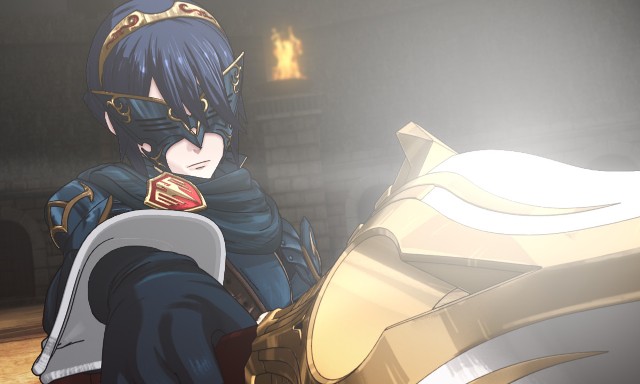
Characterisation and the power and importance of relationships drive Fire Emblem Awakening just as much as the stellar gameplay on offer. You play the part of “the Avatar” – an amnesia-stricken character of your own aesthetic creation, who becomes embroiled in a war between the neighbouring countries of Ylisse and Plegia. After being discovered in a field with no recollection of how you ended up there, you join Prince Chrom and his band of soldiers as they attempt to maintain peace whilst resisting the advances of a sinister, unholy force known as the Risen.
Far from being a silent, faceless protagonist, your character has a fascinating story which steadily becomes intertwined with the other heroes of the piece. Your band of soldiers are also much more than mere pawns on a virtual battlefield – there are some excellent and very likeable characters at play here and the ways that you can interact with your colleagues and form relationships are just as important as winning battles and advancing through the many chapters of the game. Like Disgaea, which backed up its compulsive action with a razor-sharp script (albeit one that relies on comedy a lot heavier than what we get here) Intelligent Systems have underpinned the supreme tactical action with a story that gives proceedings a real gravitas, allowing you to become emotionally involved with the characters within.
The writing is always well-judged, hitting the correct emotional peaks and troughs depending on the situation. There will be points where you feel completely gutted by an onscreen tragedy (usually when one of the main characters snuffs it) but there is also plenty of quite camp humour involved, and some odd and amusing swearing going on. Your soldiers will think nothing of repeatedly using “crap” or “arse” when chattering away, and are fond of using the near-the-knuckle but not-quite-a-swear “dastard” when describing a particularly foul villain.
Awakening opens with a stunning cinematic intro, which is among the best things I have witnessed on the console. Intelligent Systems crafted a real thing of beauty with their recent Paper Mario: Sticker Star – and have maintained their superb grasp of the hardware with a game that looks superb in every aspect. The main grid-based playing field is populated by small yet detailed sprites that depict your characters and their foes – however, unlike previous games the 3D effects give an unprecedented depth of field that is strangely thrilling. Initiate a battle and you are presented with a sequence depicting your units unleashing an attack, flinging a bombastic spell or guarding from enemy advances.
The denizens of the charming game universe are excellently designed throughout, whether they are depicted as tiny units on the top of the clamshell, or in all their anime-inspired glory during cutscenes or in the artfully drawn chat box designs. Stereoscopic 3D is employed in numerous wonderful ways, with particular kudos going to the stunning weather and environmental effects, where swirling sandstorms or glistening snowflakes are overlayed to create a sublime visual spectacle. The cutscenes in particular are absolutely mesmerizing in their execution – among the most crisp and fluid sequences I have ever seen on a Nintendo console. This is a seriously nice looking game, quite easily among the very best that the system has to offer. My only criticism – if you can call it that – is that, rather oddly, the characters don’t appear to have any feet. If anyone can tell me why this odd design choice was taken, then answers on a postcard please.
The overall excellence of the production values isn’t limited to a mere treat for the eyes. From the moment you hear the killer theme-tune, you know you are in classic Nintendo Soundtrack Territory. The tunes are rousing, memorably catchy, and suitably epic as they accompany you through the twisting, turning plot and myriad battles. Then there are the hours of cheesy English voice acting, not to mention the original Japanese tracks which are also included, and a wealth of meaty sound effects that help bring the battles to life. There are some great things going on here in the sonic stakes. It isn’t all perfect, however. Not all of the in-game dialogue is fully voice-acted, and during some sections the speech bubbles are introduced with a brief word, exclamation or other noise. Try to imagine when Navi does the cute “Hey!” thing in Zelda. Now imagine that happening about twenty times during a brief conversation between characters. It grates, and becomes very annoying, very quickly.
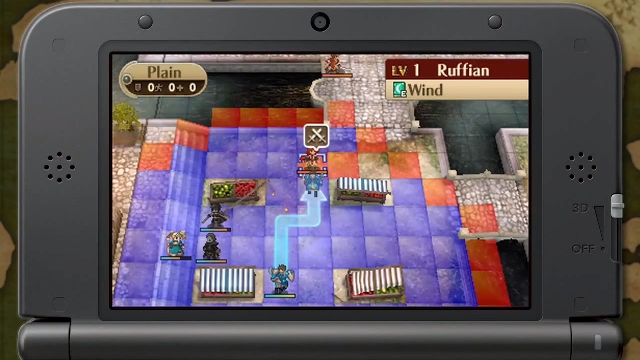
The Fire Emblem series features at its core a familiar grid setup, with turn-based gameplay involving thwarting enemies by shifting your characters around to initiate attacks and maintaining defense to preserve your precious units. The key is picking the right tools – and the right unit – for the job. A glorified farmhand with a tin pot on his head, wielding a log (I jest not, you will actually get to control this dude) is not going to be effective in battle against a heavily-armoured knight. But attack airborne enemies with archers or wind-based spells and you will notice a clear advantage. Handy on-screen stats tell you your percentages and chances of success during each duel. Each mission presents you with a goal, which is usually to eliminate all of the enemies on the battlefield in order to progress. Your units have different weapons, different classes and their own strengths and weaknesses – and it is your job as their military commander to ensure that you put the armies at your disposal to the best possible use with all of these factors in mind.
You are able to create your own Avatar character and assign them with a particular strength or weakness. The customization options are vast, however – and you can tinker with just about everything in creating a perfectly balanced party capable of matching up against a variety of opponents. Each of the other characters or military units you get to control over the course of the game has its own particular class – however you are not limited to just one. Levelling up and using specially purchased items allows your soldiers to learn new classes and skills. The excellent promotion system gives you the choice to decide how your character will progress and which skills they will learn.
Between sorties you can visit towns and villages to interact with NPCs and purchase items with the money you earn during battles. Shops sell a variety of things, including magic, weapons, healing potions and Seals which allow you to progress to a more advanced class. You can also forge your own weapons, creating custom items geared towards your fighting style. As all of your items and weapons have a limited number of uses, you have to constantly be on your toes and make sure that your party always has enough stuff to share around.
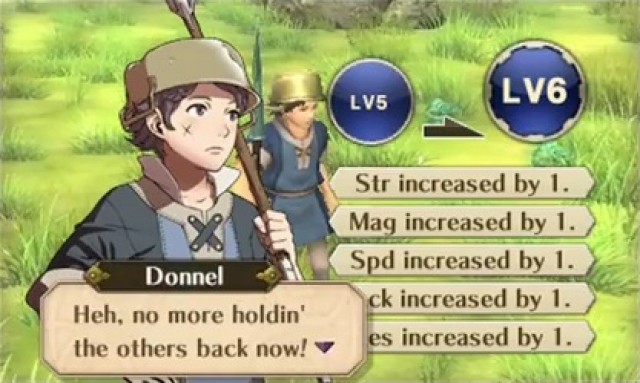
Selecting your inventory can be done manually – however, there are often lots of characters in your party and there are a shed-load of weapon classes, magic spells and other goodies to dish out. If you would rather just jump into the action with minimal fuss, you can get the AI to optimise your inventory for you. This can throw up some odd choices at times (why would Chrom want to use that damn log!?!), but does simplify matters considerably. You will also find that you steadily accumulate money that you don’t end up spending. There are plenty of weapon drops during battle and during visits to the Barracks, and apart from buying the Seals needed to progress in class, or any of the special items that allow permanent stat boosts, I don’t recall actually purchasing any weapons for my party for large portions of the game.
So far, so Fire Emblem, then – and a very impressive one at that. But Intelligent Systems have taken Awakening to the next level, setting it apart from its forebears with the way it deals with relationships and characterisation. The beautifully realised characters matter to you. You are compelled to care about them, and how their interactions both during and between battles has an effect on the course of the game. During combat, units forge relationships with each other by fighting side by side in adjacent map squares. The more a unit fights alongside a friend, the more effective that particular pair will become during battle – helping each other out at key moments or providing a boosted, more powerful dual attack. The relationships are progressed in between combat during interactions in the Barracks and in the Contacts sub-screen, yet rather than offering a simple, cursory raise of your stats, the characters actually chat with one another and hold genuinely interesting conversations. You can skip all of the chat, the same way as just about every event in the game can be skipped, even the battle sequences using the Start button, but you would be a fool to do this. Eventually characters enter into relationships that become far deeper than mere battle comrades; partners get married, and eventually fight alongside their offspring in what is a surprisingly touching development to proceedings.
Levelling your characters up, forming close bonds between them, and seeing them advance to better, more ass-kicking classes is one of the most satisfying and rewarding experiences I have had in gaming for some time. You will find yourself becoming attached to certain characters and willing them to succeed. It made me proud seeing a particularly weedy knight that – I admit, I had neglected – eventually earn enough XP so that I could progress him to Paladin rank and push him to the forefront of my assault on the Risen. Losing one of your party feels like being punched in the kidneys. There is an easy mode which allows you to resurrect fallen heroes to use in future missions, but that mode is for the weak. Go hard or go home, as they say. Fire Emblem has always been about the permanent, heartbreaking finality of death.
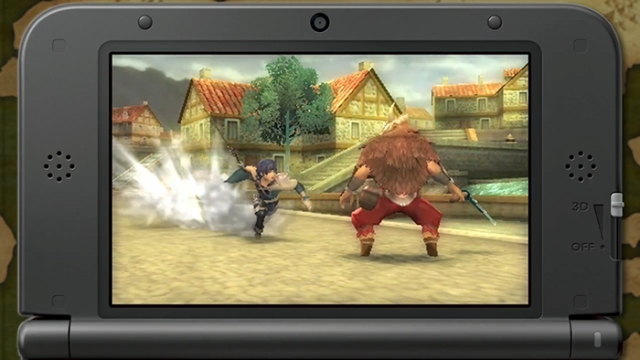
It is almost always your own daft tactical decision-making that leads to said death – and I am sure I am not the only person who found themselves reverting to a previous save in order to correct my mistake and ensure survival of my beloved level 12 Mage, who I stupidly placed within range of a zombie hellbeast riding a Wyvern. The game gets you like that. But there are some frustrating moments. Occasionally you will enter into what would appear to be a one-sided battle – your beefy Sword Master about to slice a puny mage from neck to nuts, for example – and the enemy will suddenly pull off their low-percentage Critical Hit, spelling death for your beloved party member. This is exactly why you have to approach the battles with a careful “safety first” approach.
As fun and addictive as the game can be in short bursts, there is no disguising the fact that it is very repetitive. The vast majority of the missions are simple “kill everything” affairs, occasionally calling upon you to retrieve some treasure or unlock some doors. When you do come across missions or side quests that spice things up a bit – such as the early outing during which you have to level up lowly farmhand Donnell in order to allow him to join your party – it is a nice surprise. There could have been more variety in your objectives – and the same stretches to the interaction your units have with your settings. There are some extremely nice looking and varied locales – however, the assorted terrain types have no real discernible effects on battle, save for a few points where you can regenerate HP, or areas that have slight movement penalties. When you consider that Advance Wars had game-changers like Fog of War, headquarters, weather conditions and even cities, the lack of variables on offer here is pretty poor.
Nintendo have packed an absolute ton of content into the main game – a huge number of Story missions are joined by numerous side stories which will eat up many hours of your time. There are several difficulty modes, including an extreme “Lunatic” mode for the hardcore Emblem-heads. You will need to be an experienced and seasoned tactician with a grasp of developing and fostering relationships between your units if you are to have any hope of enduring even the first battle in that mode. If that wasn’t enough, there is a cool Streetpass functionality which allows you to interact with other Emblem-owning bods to battle or trade with other players, or engage in local multiplayer in the ace “Dual Tag” modem which allows you gang up on the baddies and earn some unlockable items in the process.
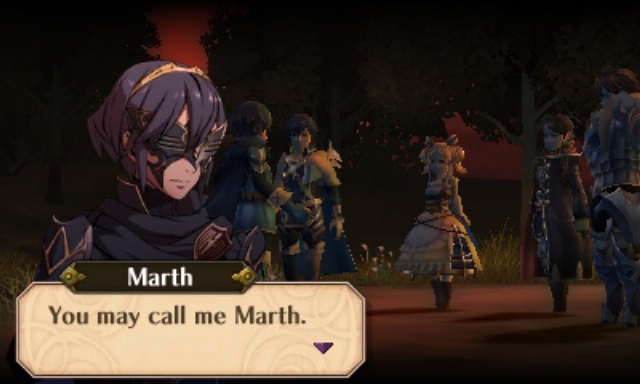
Most significantly, Awakening features downloadable content – new territory for Nintendo, but present here and promising keenly priced downloadable maps and missions which allow you to unlock and play as characters from previous games in the Fire Emblem franchise. This is a very clever and welcome move by Nintendo, which along with the online functions move this title closer to a console or PC experience in the palm of your hand.
VERDICT: In terms of pure addictive, compulsive playability, Fire Emblem Awakening joins other handheld classics like Puzzle Quest or Advance Wars. It is a game that newcomers could master with ease thanks to the variety of difficulty options, sensible tutorials and logical gameplay, but one that long-time fans will appreciate due to the way it has pushed the series forward with its choice cinematics, sublime presentation and winning relationship mechanic. Despite the many hours I have lost to its charms, it isn’t perfect: some gamers will find it repetitive and certain elements of chance a tad irritating. That said, it represents the best tactical RPG action yet seen on a handheld, and is another fine reason to own a 3DS. More than this, the excellent storylines are clear proof that Nintendo can pack a grown-up, emotional punch just as well as they deliver a whimsical slice of Mario.

BRILLIANT. This is the mark of greatness, only awarded to games that engage us from start to finish. Titles that score 9/10 will have very few problems or negative issues, and will deliver high quality and value for money across all aspects of their design.




